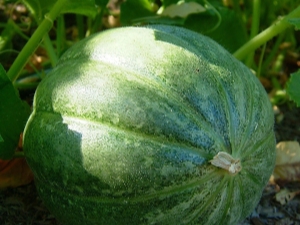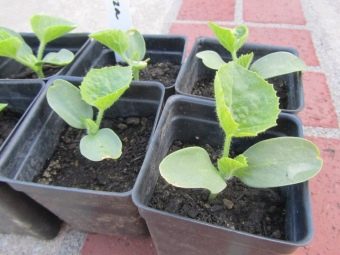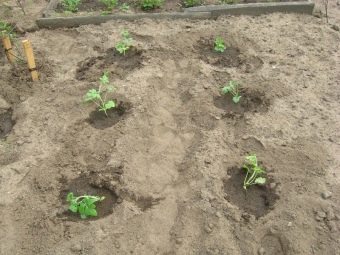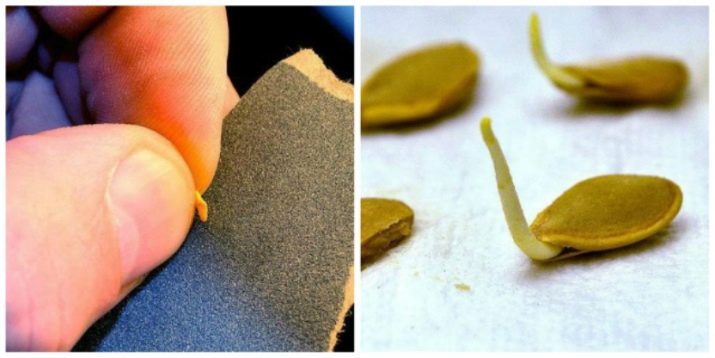The process of planting melons and watermelons in the open ground

Few people are indifferent to watermelons and melons.They are eaten raw, and they also make jams, jam and prepare candied fruits, and in addition, salt and ferment them.
Watermelons and melons belong to melons and gourds, which are known to come from the semi-desert Asian climate. That is why the plants are particularly demanding of heat and light. Nevertheless, you can get a good harvest in cool regions with a temperate climate, as evidenced by the successful experience of gardeners and farmers in the central part of Russia, forest-steppe territories of Ukraine and even Polesye.
Landing dates
Melons, like watermelons, are very thermophilic crops - the minimum temperature at which their seeds can germinate is 17 degrees. Full growth and development of saplings requires daytime temperatures of 25–30 degrees and night temperatures of not less than 20. Melon seeds tolerate drought well, but they respond extremely negatively to increased humidity and prolonged rains — in such conditions plants become susceptible to fungal infections.
Watermelons and melons should be planted in open ground only after the average daytime temperature reaches a level above 18-20 degrees, and at night it will not fall below 7. It happens that a similar temperature regime is established as early as April, but still In this case, you should not hurry, since for most of the Russian regions the return of cooling and even frosts in May up to the third decade is typical. But after that, as a rule, the weather becomes steadily warm and you can engage in planting melon.
If, however, the temperature suddenly dropped, you should cover the plants with a layer of film or special covering material, and at night add rags, straw or needles - this will protect the young plant from frost.
Growing conditions
Regional climatic features should always be considered when growing watermelons and melons. The fact is that the seedlings should be planted in open ground no later than one month after the first shoots appear, because otherwise the melons are too long and become weak and stunted, which ultimately leads to underdevelopment of the fruits. This fact should be taken into account when growing seed.
It is advisable to check with long-term weather forecasts. Usually in the middle part of Russia, the soil warms up at the end of spring or even at the beginning of summer, therefore if you plant seeds for seedlings at the end of April, then further transplantation will be successful. And if you sow seedlings in March or early April, then you can not wait for full fruiting.
However, if you have a greenhouse on your plot, then seedlings can be made at the beginning of April, so that in May the young plant can be transferred to the greenhouse. At the same time, gourds prefer the sun and light, so they do not like the greenhouse environment, they are much more comfortable to grow and develop in open space, so after establishing a stable warm weather, seedlings must be transferred from the greenhouse. This should be done in the most gentle way - along with a large lump of earth, since watermelons and melons very poorly transfer the transplant to a new place.
In order for the fruit to reach maturity, it is necessary to correctly select the variety. For Moscow region and central Russia, the cultivation of early-ripening varieties will be optimal.
Do not chase the large berries, because they may not reach maturity before the onset of cold weather.
The best neighbors for melons will be onions, beans, cabbage, peppers, tomatoes and eggplants, but after carrots and squash with zucchini you should not plant watermelons with melons.
Cooking the land for watermelons and melons should start in the fall, melon prefers light and breathable soil, and does not tolerate heavy swimming lands. Therefore, in the autumn you need to do the digging of the site and make manure (half a bucket per 1 square.m), 20-40 g of superphosphate, ammonium sulfate and potassium salt. You can also add wood ash at the rate of 250 g per square meter of cultivated area.
If the site where the planting of crops is planned is fertilized with mineral compounds for a long period of time, then it often acquires an increased level of acidity. In this case, should be liming. To do this, scatter lime on the surface at the rate of 300 g per 1 square meter. m and added dropwise to a depth of 10-15 cm.
When heating the top layer of the earth, it is recommended to add a nitrophosphoric preparation of 75-85 g / sq. m, and immediately before planting, fertilize the soil with nitrogen-containing compounds in the amount of 15-25 grams per square meter. It is best to protect the planting from the winds, creating a nearby natural barrier from high seedlings of corn or sunflower. And in order to scare off pests, should be planted near the melon sharply smelling varieties of onion, garlic or basil.
It is not recommended to plant watermelons and melons in close proximity to cucumbers and potatoes, because in this case the plants can cooperate with each other, which leads to the formation of bitterness in fruits and wilting bushes.
In addition, at first, it is quite difficult to distinguish a bush of melon from cucumber seedlings, so it is better to locate them at a distance.
How to plant?
Gourds in the garden are planted in two main ways - seeds in open ground and seedlings. Each method has its advantages and disadvantages. The choice should take into account the climatic features of the region and the varietal characteristics of the crop.
Seeds
As in the case of any other garden crop, the process of growing watermelons and melons must begin with the correct choice of seed. This topic is especially relevant for summer residents of the middle zone of our country, which belongs to the regions that are cold from the point of view of agriculture. The best will be the purchase of seeds with appropriate zoning in specialized stores. As a rule, ready-made seed material is well stored, even at the production stage it is treated with antifungal preparations, hardened and usually shows consistently good germination.
Seeds should be purchased no later than the beginning of March, since they should be prepared for planting no later than 60 days before planting in the ground.
It should be borne in mind that a good harvest from last year's material does not have to wait.
It is necessary to give preference to the material of five years ago, the yield of which is much higher. Then the seeds must go through several critical stages of preparation.
Calibration
This is sorting the seeds according to their size. It is very important, since the larger seedlings do not allow the small ones to fully develop. That is why the planting material is pre-divided into categories and, depending on their “caliber”, they are planted in separate containers. In this case, in each container you get a good and even seedlings.
Scarification
This procedure is optional, but desirable. Scarification involves intentional damage to the integrity of the seed coat in order to improve their germination. This is especially true in the case of watermelons, because their shell is hard and durable, therefore, young shoots are quite difficult to break through.
To help them, it is enough to rub each seed on the fine sandpaper with a “nose”.
Warming up
And these manipulations are strictly required for melon crops. To do this, hold soaking - the seeds are immersed in water heated to 50 degrees, and left in it for half an hour. The result of the manipulations will be the acceleration of germination, since with an increase in the temperature background in the seeds of melons, the rate of all internal biochemical reactions increases.
Disinfection
If you have purchased ready-made seed, then this stage can be neglected, however, it will also be harmful.But if the seeds are collected by you or purchased from private owners, then such measures will significantly reduce the risk of fungal and bacterial infections of the culture. For processing, light pink solution of potassium permanganate is diluted and seeds are kept in it for 20-30 minutes, after which they are dried in a natural way. Drying with the use of heaters and batteries is not allowed.
Some summer residents, in addition to the above measures, still germinate seeds immediately before planting. To do this, they are wrapped in a damp linen cloth and placed in a warm place (usually near the battery - but in no case on it).
Rag should be moistened periodically. As soon as sprouts appear, the seeds are planted in open ground.
Experts also recommend a procedure for hardening seeds. To do this, they are placed for a couple of hours in a thermos with warm water (30 degrees). Then it is kept at a temperature of 20 degrees for a day, and then it is moved for 15-20 hours in a refrigerator, and then it is kept for 5-7 hours at a temperature of 15 degrees. These activities are carried out immediately before laying in the ground. For seeds, prepare wells with a depth of 5 cm, spread the seeds, sprinkle them first with wet and then dry ground.
The landing scheme is as follows:
- for watermelons, the distance between the holes should be 0.8–1 m, and the size between the rows should be 1.5–2 meters;
- Melon seeds are planted in 0.7 m increments, and the beds are placed at a distance of no more than 1 meter.
Long-eyed varieties are planted less frequently, and short-strikers are more common. Experienced gardeners recommend in each well put 1 tbsp. l wood ash, 1 tsp. nitroammofoski and a couple handfuls of compost or rotted manure.
A couple of weeks before the proposed planting date, cover the surface of the area with black plastic wrap - this will increase the degree of warming up of the ground, and immediately after planting, create a shelter of special agrofibre - it will protect the plant in case of an unexpected decrease in temperature.
Seedlings
Summer residents with experience in growing melon crops recommend using the seedling method of planting watermelons and melons. This technique allows you to solve several problems at once:
- To raise the level of seed germination, since in most of Russia it is not always possible to provide the most optimal conditions for seed germination in the soil;
- Get an early harvest. It is noticed that with the help of ready seedlings the very first fruits ripen 2-3 weeks earlier than those grown using the first method.
- Extending the ripening period is important for late-ripening varieties that require 90-100 days to form mature fruits (unfortunately, this time is not always enough, especially in years with a long spring or early autumn).
- Reduce the risk of wireworm injury.
Planting seeds of melon seedlings is carried out around the second decade of April.
The optimal conditions for seed germination is a temperature of +30 degrees - then you can wait for the first shoots after 6 days, and immediately after the emergence of shoots the temperature can be reduced to 18 degrees. After a couple of days, during which the sprouts adapt, it is necessary to remove weak seedlings and again raise the temperature to 25 degrees, dropping at night to 18.
Such a thermal regime should be maintained for 3 weeks while the seedlings grow and grow stronger.
If we talk about the agrotechnology of planting seedlings, it includes three basic stages:
- seed germination;
- waiting for germination in the total capacity;
- seating young plants.
For the first stage, no special means are required, at this stage it is only necessary to prepare the material. Varietal seeds are preliminarily placed in fabric bags and soaked for 1.5–2 hours in warm water, after which they are removed and kept on wet sand or sawdust for three days so as to prevent the substrate from drying out.This helps to reduce the waiting time for germination.
In the second stage, the seeds that are crooked are planted to obtain healthy, full-fledged seedlings. These manipulations are performed in a container with a flat surface and a significant size - young shoots should not interfere with each other to grow and develop.
In addition, placing them on the same area will allow you to quickly and easily set the overall temperature and control the degree of illumination.
We pay attention to the fact that plastic containers should be sterilized without fail before planting watermelon and melon seeds in them.
Well, after the sprouts get stronger, they will need a pick, when each future bush is planted in a separate container. Optimally, if this is a 10x10-sized pot, 12x12 is better - in this case, the emerging seedling will have enough space for proper growth, it will receive all the necessary micro and macroelements and form a strong root system, since all further cultural development depends on the roots and its yield.
It is best to use peat containers, because in the future you can plant a plant in open ground with them. In this case, you can avoid injury to the roots, and rotting, peat will further enrich the soil with nutrients.
Land for growing bahchi can be bought in specialized stores, it will contain all the necessary nutrients, and in addition, it will be sterilized and processed from pathogenic microflora. However, you can prepare the mixture yourself. To this end, take on a kilogram of sod land, peat, compost or rotted manure. The resulting mixture should be mixed, and then sieved, then add sand so that it is about 1/5 of the resulting volume of soil - it improves the drainage of the earth.
You can enter a little wood ash, which not only enriches the substrate, but also serves for additional disinfection. The finished composition must be poured with water, heated to 80-90 degrees, and then treated with a weak solution of potassium permanganate. Some gardeners recommend that the land be prepared this way in the fall, and for the winter, it should be frozen outside so that sub-freezing temperatures destroy all the harmful bacteria.
The seedling needs good lighting, its daylight should be about 12-13 hours, otherwise the seedlings will stretch and become sluggish and stunted.
To do this, you should take care of additional coverage of seedlings, since natural insolation at this time of year is not enough to provide the required level of illumination.
After 2 weeks, young plants should be fed with a solution of a fermented mullein, previously diluted with water in a ratio of 1 to 10, and after another 2 weeks, a second bait is needed, only this time it is recommended to add 30 g of potassium sulfate, 15 g of ammonium sulfate and 50 g to the mullein. superphosphate per liter of water.
Keep in mind that watering should be moderate. Bakhcha transfers drying more easily than excessive waterlogging.
When the plant enters the phase of 5-7 leaves, it can be planted in open ground. A week before this, hardening of seedlings should begin. To do this, the plants are taken out for a day for a few hours, and immediately before being placed in a permanent place, they should “live” on the balcony or in the courtyard for several days.
On the eve of transplantation, seedlings should be moistened abundantly and sprayed with a weak solution of Bordeaux mixture.
All work on the planting of melon seedlings should be carried out in the morning before the sun starts to burn. Each plant, together with a lump of earth, is transferred to wells prepared in advance in 0.7-1 m increments. The stem is buried to the level of cotyledon leaves.
After planting, seedlings are watered abundantly and covered with a film or a cut part of a plastic bottle (bulk containers should be used, standard 1.5-liter containers are not suitable for this) or a paper cap.
The soil around the planting should be lightly dusted with sand - it will maintain the required level of moisture and prevent the occurrence of putrefactive processes.
Two weeks after planting, the plant should be fertilized with ammonium nitrate, and at the stage of bud formation, an infusion of mullein or bird droppings should be introduced into the soil.
Tips
To get a good harvest of watermelons and melons, it’s not enough to plant them correctly plants require care, which comes down to the following activities:
- Watering. Young seedlings need good moisture, so it should be watered quite abundantly, but not more than 1 time in 7-10 days. As soon as the flowering stage begins, watering should be halved, and after the formation of the ovary, and completely stop.
- Shelter. As a rule, film or plastic containers protecting plants from adverse atmospheric factors at the adaptation stage are removed at the end of June, but this can be done earlier or later, depending on the night temperature in the region. It is very important to protect the planting from rain and wind, but one should not forget to air the shelter, otherwise the young plant will simply suffocate in it.
- Pollination. Usually there is no problem with pollination, since in summer in the middle lane there are quite a few flying insects. But if the period of flowering coincides with cloudy or rainy weather, then pollination should be carried out manually; for this, the stamens of one flower should touch the pistils of another.
- Pest protection. Gourds very often suffer from aphids, wireworm, meadow moth, sprout flies and scoop. If you find these insects before they spoil the fruit, it makes sense to treat the seedlings with bioprotection drugs, for example, "Fitoverm". But if the number of pests creates a real threat to the death of the entire crop, then insecticides should be used. These include "Aktar" or "Fufanon", well helps to fight with "Tantarek" aphids.
- Disease protection. Like any other horticultural crops, melons can suffer from fungal and bacterial ailments. Quite often, plants are affected by powdery mildew, ascochytosis and anthracnose. For the purpose of prophylaxis, cultures are sprayed with “Ordan”, “HOM” or colloidal sulfur compounds.
In regions with an unfavorable climate, gourds are grown in greenhouses and greenhouses. In order for it to occupy as little space as possible, special trellis are used so that the bushes stretch and develop upwards.
Planting melons in greenhouses produced in cooked holes. As a rule, they are dug out with a diameter of 50-70 cm, between each leave 20-30 cm.
Preparation of seeds and seedlings for greenhouses is no different from similar activities for open ground, seedlings are also grown and hardened, fed and watered. Peppers and tomatoes are often grown with them, but it’s better to abstain from the neighborhood of squash and cucumbers.
In each well, you need to make up to 1.5 kilograms of rotted manure or compost, then sprinkle it, pour it abundantly, and only then transfer the seedlings with an earthy clod.
The greenhouse must be regularly ventilated, and periodically fertilized with nitrogen-containing preparations.
Garden beds with gourds in greenhouses are watered once a week, but shortly before full maturity, watering is stopped.
So in conclusion, we will talk about folk remedies that help to achieve a good harvest of melons and gourds even in the most adverse weather conditions.
Yeast and liquid ammonia are considered the most popular means among a variety of fertilizing. Baker's preparations are used for yeast fertilizer. The powder solution increases the fertility of the soil, as well as stimulates increased plant growth.Yeast contains a lot of beneficial microorganisms, macro- and microelements. In this case, the root system develops much faster. The result of the application of such dressings is the formation of a strong powerful plant.
Ammonia is also often used in the cultivation of watermelons and melons. This drug is composed of nitrogen, so the melons are all necessary for the growth of shoots and leaves. However, this composition should be used only in the case when it is not possible to save the plant by other means.
Planting and growing watermelons and melons is an occupation for hardworking and ambitious people who have set themselves the difficult task of getting good fruit in the central zone of Russia.
But if you comply with all the requirements of agricultural engineering and devote enough time to preparing and germinating seeds, planting seedlings and caring for seedlings, then at the end of summer you can get juicy tasty fruits of homemade watermelons and melons, which both adults and children love so much.
You will learn more about how to plant abruses in open ground from the following video.






















































